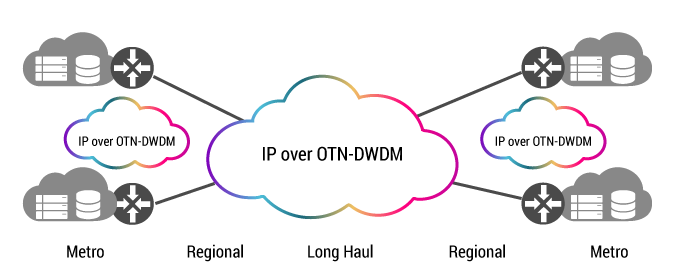Are We Finally Entering the IP-over-DWDM Era?
Study the past if you would define the future.” ― Confucius
In the beginning, system engineers created a single layer network to support a single service, voice communications. This reached its zenith with SDH/SONET, which mapped TDM-encoded voice directly onto fiber optical transport. Everyone was happy.
Then pesky packet-switched data services came along that did not behave at all like voice. Still, it was possible to accommodate data transport needs using packet-over-SDH schemes. These were not particularly efficient, but as data only accounted for a fraction of overall traffic, everyone was only a little unhappy.
About twenty years ago, these data services – and in particular, Ethernet services using IP connectivity – began to surge. It was no longer possible to ignore their impact on transport traffic. Serendipitously, at the same time, developments in optical multiplexing and amplification technologies enabled multi-channel DWDM optical networks.
The result was the Optical Transport Network. Also called a “digital wrapper” technology, OTN efficiently framed different types of service layer interfaces into an electrical format prior to conversion and transmission as optical signals over DWDM facilities. OTN-DWDM transport had many benefits:
- It created an agnostic transport mechanism for any type of end-user communications service.
- It made it easy to combine or “groom” multiple services onto a single optical channel, wasting no bandwidth illuminated by expensive transponders.
- It optimized optical transmission using forward error correction (FEC), and featured integrated operations support.
The TDM engineers (responsible for OTN-DWDM optical transport, and legacy SDH/SONET) loved this arrangement. It let them continue what they did best, building and operating deterministic carrier-grade networks.
The Ethernet/IP camp hated it. They built their service networks on entirely different statistical multiplexing principles. It annoyed them to no end that they needed to rely on a separate network – and even more galling, a separate organization – for their low cost optical transport needs. They began advocating for an “IP-over-DWDM” approach.
With IP-over-DWDM, they would integrate OTN transponders directly into IP routers and switches. They would use OTN’s optimized transmission and throw away all of OTN’s multiservice and electrical switching capabilities. This approach found use in applications like carrier Ethernet or mobile backhaul that could use pluggable transceivers or lower power OTN transponders appropriate for limited geographic scope.
But IP-over-DWDM never occurred in a big way. The main reason being that IP routers and switches place a premium on faceplate density. The OTN transponders were generally big and power hungry. They consumed too much real estate that could be devoted to denser client interfaces. This was particularly true for very high power long haul transponders.
It was much more efficient to use low power, grey optics transceivers to interface with the already existing OTN-DWDM optical layer, and make use of their transponders. This approach could also take advantage of ROADM optical switching already engineered into this layer, to obtain added benefits of router bypass topologies and dynamic wavelength restoration. The Ethernet/IP camp ignored that this OTN-DWDM layer also supported other services and provided capabilities they did not use.
Fast forward to today, where we have in fact returned to a single predominant communications service, but instead of voice, it is indeed Ethernet/IP connectivity. There is no dispute that today, the Ethernet/IP service transport layer carries the vast majority of data, storage, video and even voice services.
We are also seeing for the first time a true multi-vendor DWDM standard emerge around 400GZR/ZR+. In about a year, this will give rise to a new generation of small form factor DWDM pluggable transceivers, which will implement the proven OTN transmission standard and be deployable with high efficiency in IP routers and switches.
Therefore, it is fair to ask the question: “Is it time to return a single network, namely IP-over-DWDM, where Ethernet/IP connectivity is coupled tightly to underlying optical transport.” The opinion of the author is that this indeed will occur, but not entirely, and it will take time.
Projecting five years into the future, I predict widespread adoption of IP-over-DWDM for data center connectivity across metropolitan and into regional areas. The new pluggables will be ideally suited for this application and can deliver great cost reductions. These will mainly be point-to-point connections although we may see some limited use of purpose-built ROADM switching.
In five years, the evolution of the existing OTN-DWDM optical transport network will still predominantly cover regional and long haul connectivity. Pluggables will not yet have enough power to deliver this well. Moreover, this type of networking also benefits from general flexibility provided by ROADMs, and in some cases OTN switching, which a distinct layer delivers best. It will be interesting to see whether Ethernet/IP engineers will consider using OTN switching to obtain hard QoS to support 5G low latency services that will start emerging at about that time.
Notwithstanding this question about delivering hard QoS, it is likely that the multi-service OTN mission of a distinct optical layer will diminish in the future, as it becomes devoted to Ethernet/IP traffic. This gives rise to another interesting question as to who will control the optical layer. It is easy to see its budgets and ownership starting to merge organizationally under the leadership of the Ethernet/IP engineers, or perhaps even the data center IT engineers. Since organization is usually more important than technology, this change could indeed bring us back to a combined services plus optical network, devoted to Ethernet/IP connectivity. In other words, IP-over-DWDM.





